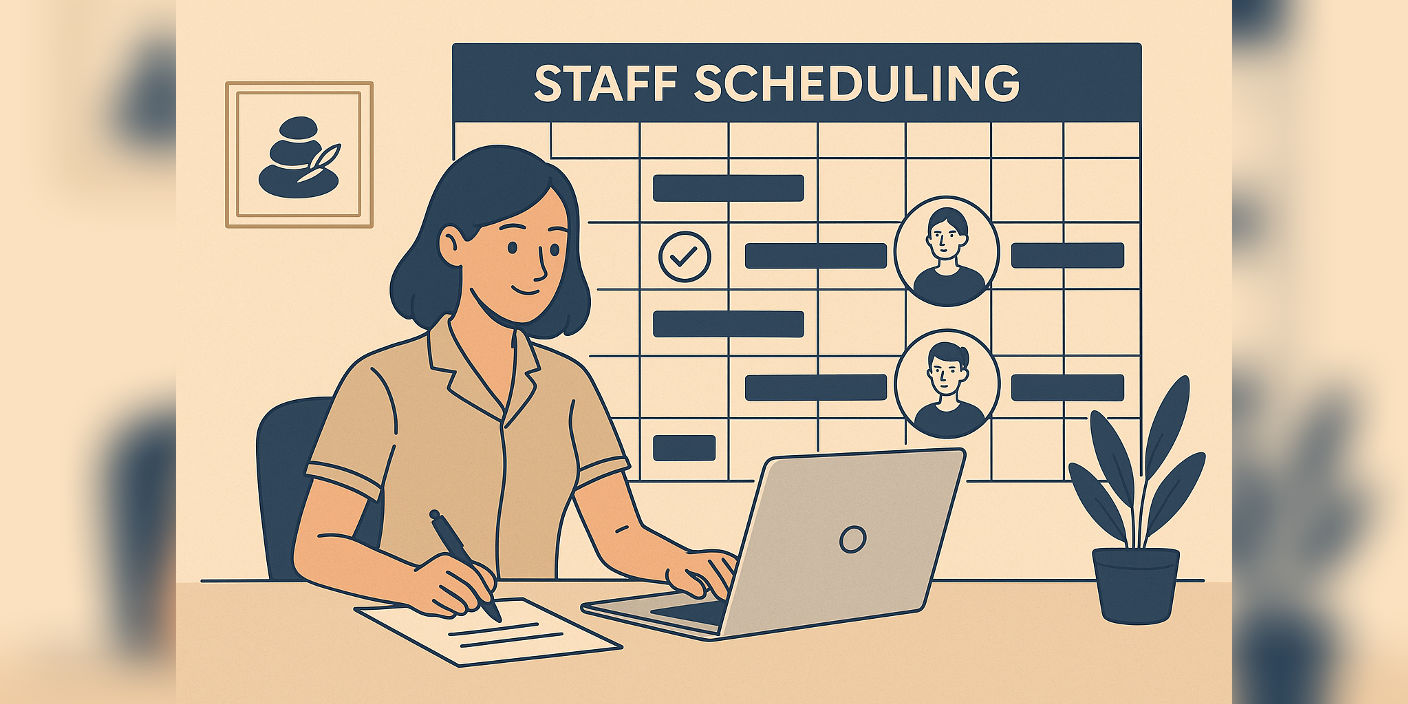
المدونات
Staff Scheduling for Spas: The Complete Operational Framework

Why Spa Scheduling Matters
Poor staff scheduling costs spas up to 15 hours weekly in wasted time, double-bookings, and therapist burnout. The difference between chaotic manual scheduling and organized systems? Profitability, staff retention, and client satisfaction.
This framework solves the real challenges spa owners face daily.
The 7 Most-Asked Scheduling Questions
1. How Long Should Buffer Time Be Between Appointments?
The ideal gap is 5–10 minutes, depending on service type. Massage and facials need cleaning time for linens, tools, and room prep. Longer services (couples’ massages, body treatments) require 10 minutes. Quick services (nails, hair) need 5 minutes.
Building in buffer time prevents rushing errors, improves client experience, and decreases staff fatigue. Most spas find that 7-minute buffers balance efficiency with quality.
2. What’s the Best Way to Schedule Staff for Peak Hours?
Peak spa hours typically occur between 10am–12pm (morning rush) and 5pm–7pm (after-work appointments). Schedule your best therapists during these windows and stagger start times to create coverage waves.
Use data from your POS system to predict peaks. If Saturdays see 60% more bookings, increase staff by 40–50%. Assign senior staff to peak hours and newer team members to slower periods for training.
3. How Do I Reduce Staff Turnover Through Better Scheduling?
Flexible scheduling is critical — employees who control their availability stay longer. Create predictable schedules and post them 2–3 weeks in advance. Surprise shift changes cause stress and resentment.
Offer shift-swap features so staff can exchange hours fairly. Spas with flexible scheduling report 34% lower staff turnover. Track shift satisfaction through quarterly surveys and adjust based on feedback.
4. How Can I Prevent Double-Booking and Scheduling Conflicts?
Double-booking happens when the same therapist is assigned two clients simultaneously or a room is booked for overlapping services. Solutions include:
- Use scheduling software with conflict detection
- Color-code therapists and rooms on your calendar
- Set availability rules per staff member
- Track room inventory carefully
- Build in buffer time between appointments
Scheduling software prevents double bookings instantly. Manual spreadsheets cause 60% more conflicts than software systems.
5. What’s the Impact of No-Shows on Spa Scheduling?
Prevention tactics include automated SMS/email reminders 24 hours before appointments, requiring deposits for high-value services, and charging cancellation fees. Spas with reminder systems report 40–50% fewer no-shows.
6. How Should I Schedule Staff for Multiple Spa Locations?
Multi-location scheduling requires centralized visibility. Designate therapists who can work across locations, add 30-minute commute buffers, and standardize job titles. Spa scheduling software manages multiple locations easily with location-specific views and real-time sync to prevent double-booking across branches.
Building Your Scheduling Framework
Step 1: Analyze Demand Patterns
Pull 12 weeks of booking data from your POS system. Create a heatmap showing which times are busiest. This data reveals your busiest times and slowest periods.
Step 2: Map Service Duration Standards
Set firm service durations:
- Deep tissue massage: 90 minutes
- Facial: 50 minutes
- Hair styling: 45 minutes
- Nail polish: 20 minutes
Train therapists on time management and use timers to maintain consistency.
Step 3: Build Your Shift Structure
Design overlapping shifts that cover peak hours. For a 6-therapist spa, consider:
- Early shift: 8am–2pm
- Mid shift: 11am–5pm
- Evening shift: 3pm–8pm
Overlap periods ensure peak coverage with backup.
Step 4: Account for Time-Off and Variations
Pre-approve vacation dates 6 weeks ahead. Rotate scheduled days off fairly. Designate one “floating” therapist for call-outs.
Step 5: Implement Technology
Use scheduling software to automate conflict detection, staff notifications, client reminders, time-off requests, and labor cost reporting. This saves time and reduces human error.
Step 6: Monitor and Adjust
Review weekly for gaps and over-booked days. Monthly, calculate labor cost percentage (aim for 28–35% of revenue). Quarterly, modify shift times based on pattern changes.
Regional Considerations for GCC Spas
For Kuwait and other GCC locations, adjust for Friday–Saturday closures, Ramadan (extend evening hours, shorten afternoon slots), and national holidays. Plan schedules 4 weeks in advance for Ramadan. Many staff take June–August off; plan ahead accordingly.
Metrics to Track
Monitor these key metrics monthly:
- Labor Cost %
- Scheduling Conflicts
- No-Show Rate
- Staff Utilization
- Therapist Turnover
Conclusion
Effective spa staff scheduling is the backbone of operational efficiency and staff satisfaction. By analyzing demand, setting standards, using technology, and monitoring metrics, you’ll save 8–15 hours weekly and reduce scheduling conflicts by 90%.
Start implementing this framework today. Your business — and your team — will thank you or discover smart scheduling tools designed for modern spas at سباركلز
